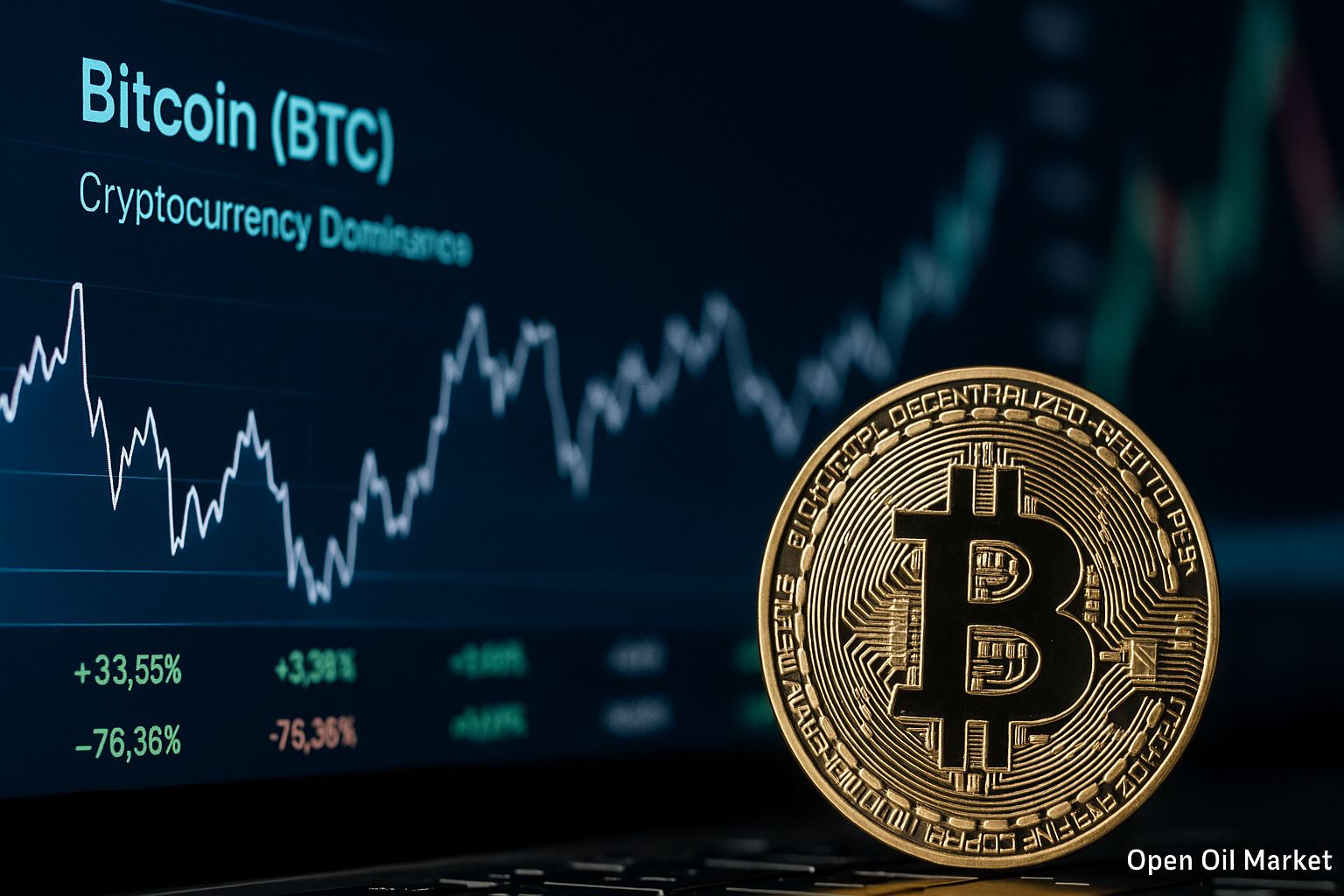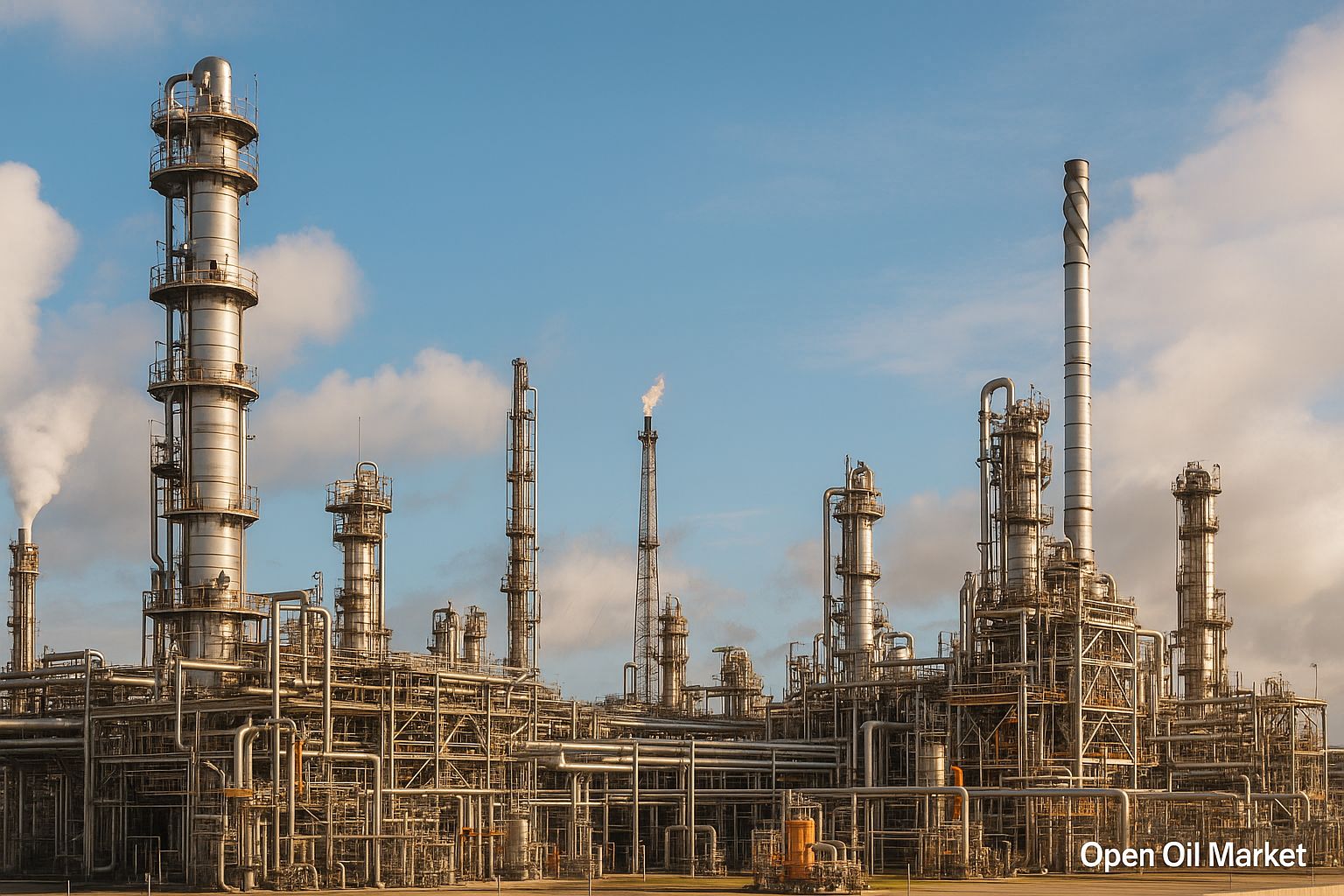
Current Oil Market News as of November 10, 2025: Oil Market Balance, Strong Gas Reserves in Europe, Growth of Renewable Energy, Technological Trends, and Sanction Pressures. Analytics for Investors and Energy Sector Companies.
The global fuel and energy complex is entering mid-November under heightened geopolitical tension and noticeable structural shifts in commodity markets. The sanctions standoff between Russia and the West continues to impact the oil and gas industry: at the end of October, the U.S. expanded restrictions on the largest Russian oil companies, while the European Union approved another sanctions package, complicating international operations. Simultaneously, the global oil market demonstrates relative balance leaning towards oversupply: production remains high while demand growth slows. The European gas sector heads into the winter period with solid, albeit not record, fuel reserves, instilling confidence in the stability of supplies. At the same time, the energy transition is accelerating – many countries are reporting new records in renewable energy, although the variable nature of green generation still requires support from traditional sources. Below is a detailed overview of the key events and trends in the oil, gas, electricity, and other energy sectors as of the current date.
Key Takeaways
- Oil: Supply from OPEC+ and record production in the U.S. keep oil prices within a moderate range ($60–64 per barrel of Brent), despite ongoing geopolitical risks.
- Gas: Europe enters winter with high gas reserves (around 85% storage capacity), and diversified LNG imports compensate for reduced pipeline supplies, while price volatility is limited by weather factors.
- Sanctions and Geopolitics: New measures from the U.S. and EU increase pressure on the Russian energy sector, raising risks and costs for export flows; companies and investors are adapting through market and logistics reorientation.
- Asia: The largest emerging economies (China, India) remain key demand drivers for hydrocarbons, balancing the benefits of cheap supplies with energy security goals while increasing investments in renewable energy.
- Electricity and Renewables: Global generation from renewable sources reached record levels in 2025, with accelerated construction of wind and solar plants; however, the problem of energy variability requires active development of storage systems and grid modernization.
- Fuel Market in Russia: In Russia, temporary restrictions on gasoline and diesel exports have been extended, alongside measures to support refineries, stabilizing domestic prices for petroleum products after a summer surge.
Oil Market: Balancing Supply and Slowing Demand
Prices. As of early November, global oil prices remain comparatively low after a decline in the fall. The benchmark Brent blend is trading in the range of approximately $62–64 per barrel, while U.S. WTI is around $59–60 per barrel. These levels are significantly lower than summer peaks, reflecting a market balance shift towards oversupply. Geopolitical factors (conflicts and sanction risks) add a slight premium to prices, but overall, market participants are cautiously optimistic.
- Supply: OPEC+ countries are gradually increasing production after previously implemented restrictions. In an extraordinary meeting in early November, the alliance agreed on a symbolic quota increase (~+137 thousand barrels per day from December), postponing a more substantial rise until the first quarter of 2026. Concurrently, U.S. oil production has reached a record level of ~13 million barrels per day – driven by the shale boom and easing environmental regulations. High supply from OPEC+, the U.S., and other independent producers eases the global balance.
- Demand: Global oil consumption growth has noticeably slowed. According to the International Energy Agency (IEA), demand growth in 2025 is projected to be less than 1 million barrels per day (for comparison, in 2023, demand grew by more than 2 million barrels per day). Economic slowdown, particularly in China, high prices from previous years that encouraged energy conservation and efficiency improvements, as well as the accelerated adoption of electric transport, constrain oil consumption growth.
- Reserves: Commercial oil and petroleum product stocks outside of OPEC have increased in recent months. In the U.S., a notable replenishment of oil reserves has been recorded in the fall, partly due to record production. Additionally, some sources previously restricted have returned to the market: for example, export supplies from the Kurdistan oil region (Iraq) resumed after a long hiatus. The increase in reserves adds upward pressure on prices.
Outlook. The oil market is finishing the year in a state of relative balance, leaning towards oversupply. Without significant unforeseen circumstances, prices will likely remain within a moderate range until year-end. Concerns about possible supply disruptions or further tightening of sanctions prevent prices from collapsing; however, expectations of increased supply from OPEC+ and shale producers create bearish sentiments. Oil sector companies are focusing on cost control and risk hedging, while refiners strive to optimize product output (gasoline, diesel, aviation fuel) and logistics in a moderate price environment.
Gas Market: Europe Braced for Winter
Situation in Europe. On the natural gas market, the situation remains relatively stable, although the approaching winter keeps participants on edge. European countries have managed to accumulate substantial volumes of gas in advance: according to Gas Infrastructure Europe, storage facilities in the EU are approximately 85% full by early November. This is below nearly 100% a year ago, but still provides a solid reserve margin in case of a cold winter. Diversification of supply sources has compensated for the reduction of Russian pipeline gas. Record LNG imports from the U.S., Qatar, and other exporters support supply in the European market.
- Reserves and Imports: The high level of storage capacity combined with ongoing LNG supplies means Europe is entering the heating season well-prepared. Weak gas demand in Asia in the first half of the year has also played to Europe's advantage, allowing the redirection of additional LNG cargoes to European terminals.
- Prices: Thanks to reserves and alternative imports, wholesale gas prices in the EU remain significantly lower than the peaks of 2022. In recent months, prices have fluctuated within a moderate range, primarily responding to weather changes. If the winter is not extremely cold, and competition from Asia for new LNG shipments remains mild, the European gas market stands a good chance of navigating the season without price shocks.
- Demand and Generation: Efforts toward energy efficiency and the economic situation restrain the growth of gas consumption in industry. Nevertheless, gas continues to play a key role in power generation as a balancing fuel: when generation from wind or solar plants falls, the EU's energy sector is compelled to increase reliance on gas (and at times coal) generation, as seen in autumn during the weak winds in Northern Europe.
Markets and Risks. Overall, the European gas market demonstrates resilience. Traders and energy companies closely monitor weather forecasts and schedules for LNG repairs/supplies to respond promptly to changes in balance. The key uncertainty remains temperature: prolonged cold spells could increase gas withdrawal from storage and push prices higher. However, compared to previous years, Europe feels more confident due to the accumulated reserves and diversified import routes.
Electricity Sector: Supply Stability and Nuclear Renaissance
In the electricity sector, key markets maintain supply stability, and governments focus on ensuring energy security amid the transition to clean energy. In 2025, several countries have intensified support for baseload capacities: for instance, Japan has announced plans for the accelerated restart of idled nuclear reactors, aiming to reduce hydrocarbon imports and curb inflation. This nuclear renaissance is also observed in other regions – more countries are considering nuclear generation and modern small reactors as a means of ensuring the reliability of energy systems while achieving decarbonization goals.
Simultaneously, there is ongoing modernization of electrical networks and development of "smart" infrastructure to integrate the increased share of renewables. Energy companies are investing in digital demand management systems and distributed networks to enhance supply flexibility. In the short term, thanks to sufficient reserves of traditional capacities (gas, coal, and nuclear plants) and accumulated fuel stores, the risk of electricity shortages this winter is minimal. However, the long-term trend of the energy transition requires the industry to maintain a constant balance between adopting new technologies and ensuring grid reliability.
Renewable Energy: Record Growth and Variability Challenges
The renewable energy sector is experiencing accelerated development in 2025. According to industry reports, global installed renewable capacity has significantly increased: major solar and wind power plants are being commissioned from China and India to Europe and the U.S. Global generation from solar and wind has reached new highs – in the first half of 2025, it surpassed generation from coal plants for the first time. Leading energy companies and investment funds are continuing to channel record amounts into clean energy projects, while governments stimulate the sector through targets and subsidies (for example, the UK aims to double clean energy jobs by 2030).
- Investments and Capacity: Annual investments in renewables are setting new records, approaching $700 billion in 2024, and continuing to grow in 2025. Capacity additions have increased by more than 10% compared to the previous year. However, to meet the global target of tripling renewable capacity by 2030, set at the COP28 summit, this growth is still insufficient – experts call for doubling annual rates of renewable capacity construction and grid modernization.
- Infrastructure Challenges: The rapid increase in renewable energy share exposes integration challenges. In some regions in 2025, there were periods when generation from wind and hydropower fell due to weak wind or drought. To cover the shortfall, there was a temporary increase in generation from gas and coal plants, which contradicts emission reduction targets. These instances highlight the need for accelerated development of energy storage systems (industrial batteries) and construction of flexible backup capacities.
- Company Strategies: Oil and gas companies and energy corporations are actively responding to energy transition trends. Many are increasing investments in solar and wind projects, bioenergy, hydrogen, and carbon capture technologies. Such portfolio diversification will help them remain competitive as fossil fuel shares gradually decline in the global energy system.
Conclusion: Despite record progress, the world is still far from climate goals. The development of renewables must be accompanied by infrastructure modernization and new policy measures to overcome barriers and ensure sustainable growth of the sector without energy supply disruptions.
Coal Sector: Demand Decline and Price Stabilization
The global coal market in 2025 is influenced by a long-term trend of declining coal's role in the energy balance. Analysts estimate that global coal consumption may decrease by approximately 5–10% by year-end, as large economies gradually transition to cleaner energy sources. The drop in demand, especially from China for imported coal, and the overall market saturation have resulted in a moderate decline in prices compared to last year's levels. Futures for energy coal have stabilized around $100–110 per ton (for comparison, this is a quarter lower than in the fall of 2024).
- Regional Features: In Europe and North America, coal use for energy continues to decline – old coal-fired power plants are being closed or repurposed for gas and biomass as part of climate policy. In Asia, on the other hand, coal still remains a substantial fuel: India and some Southeast Asian countries are still commissioning new coal capacities to meet rising electricity demand. However, even there, appetite is being restrained – projects are increasingly being reconsidered in favor of renewables or gas.
- Exports and Production: Major coal exporters (Australia, Indonesia, Russia, South Africa) have faced declining external demand. For instance, U.S. coal exports fell by more than 10% in the first half of 2025 due to reduced purchases from China and an overall oversupply in the global market. Mines are scaling back production in response to lower demand to avoid excessive stocks。
- Price Environment: After sharp price jumps in 2022 amid the energy crisis, the coal market in 2025 is relatively calm. While current prices have risen by 5–7% over the last month due to seasonal demand increases during the heating season, they remain significantly below the record highs of the past decade. Market equilibrium is maintained as supply quickly adjusts to declining demand – for instance, several outdated capacities are being closed, preventing prices from dropping too low.
Outlook. In the future, climate agenda pressure will intensify: more countries are setting deadlines for the phase-out of coal generation (2040s for many developed countries). In the meantime, developing economies focus on emission cleaning technologies and gradually reducing coal's share. For investors, the coal sector becomes a higher-risk area, although short-term price fluctuations are possible depending on weather and market conditions in Asia (for example, demand for coking coal from metallurgy).
Oil Products and Refining Market: Stable Supply and Government Regulation
The global oil products market at the end of 2025 is characterized by relatively stable prices and an ample level of supply. Gasoline and diesel prices have fallen compared to peak levels from last year, reflecting lower crude oil costs and the absence of acute shortages in major markets. At the same time, refining margins for refineries remain tight due to high costs and declining long-term demand for traditional fuels.
- Supply: Newly commissioned refining capacities in the Middle East and Asia (including major refineries in China and the Persian Gulf countries) have increased global fuel supply. Concurrently, several outdated refineries in Europe and North America have reduced processing or closed due to weak profitability and environmental requirements. Overall, global refining capacities are adequately meeting demand, ensuring sufficient supply of gasoline, diesel, and aviation fuel in the market.
- Demand: Gasoline consumption is stagnating or declining in developed countries as the fleet of electric vehicles increases and fuel efficiency in internal combustion engine vehicles improves. Diesel demand is also facing structural pressure – more efficient technologies and alternatives are being adopted in freight transportation and industry. The only segment showing a recovery is aviation fuel (kerosene), where consumption is rising with the revival of international flights, although it has not yet reached 2019 levels.
- Regulation in Russia: In Russia, the policy of strict control over the domestic oil products market has continued into autumn 2025. The government has extended the temporary ban on automotive gasoline exports until year-end (with a possibility of extension into 2026), and diesel export restrictions remain in place – foreign shipments are only permitted when the domestic market is fully supplied. Concurrently, the dampening mechanism for compensation to refiners has been adjusted: the price threshold for reduced payments has been raised, which decreases export viability amid high global prices. Additional fuel volumes have been redirected from reserves to regions experiencing summer shortages to normalize the situation.
Results. The complex of measures adopted has helped stabilize fuel prices within Russia during the autumn. Wholesale prices for gasoline and diesel, which peaked in August, have declined and remain in a narrow range. Retail prices have ceased to rise sharply, although they still remain above last year’s levels. Thanks to improved supply for filling stations and the completion of the harvest, tension in the domestic fuel market has eased. Experts note that should oil prices remain stable, the government may gradually lift export restrictions in early 2026, but only if the domestic market is fully saturated and prices for consumers sustainably decrease.
Technological Trends in Energy: Electric Vehicles, Hydrogen, and Digitalization
Technological progress continues to transform the fuel and energy complex, setting the course for development for years to come. One of the key trends remains the mass adoption of electric transport. In 2025, sales of electric and hybrid vehicles are hitting records: according to industry analysts, global sales of electrified vehicles exceeded 2 million units in September, a quarter more than the previous year. China and Europe lead in the pace of transportation electrification, and by year's end, the share of electric vehicles may exceed 20% of all sold cars. The rapid growth of the electric vehicle fleet is beginning to impact demand for motor fuels—especially gasoline—in several countries.
Another strategic direction is the development of hydrogen energy and infrastructure. Governments and major energy companies are investing in green hydrogen projects: electrolytic capacities are being constructed, and supply chains for using hydrogen in industry, transportation, and energy are being established. In Europe, a program for the creation of hydrogen hubs is in place, while projects for exporting ammonia and methanol based on hydrogen are being implemented in the Middle East, and hydrogen fuel cells are being rapidly adopted in transportation in China and Japan. Although hydrogen still occupies a negligible share of the balance, 2025 marked the start of several commercial hydrogen projects, bringing this technology closer to widespread use.
Digitalization and innovation are also changing the industry landscape. Oil and gas companies are actively implementing artificial intelligence and big data analytics to enhance efficiency: these tools are used to optimize production at fields, predict equipment wear, and improve trading of energy resources on exchanges. Smart energy systems, which include intelligent grids and energy storage devices, enable load peak smoothing and greater integration of renewables without compromising reliability. Advances in battery technologies continue to reduce the cost of energy storage – large lithium-ion and sodium-ion batteries are being deployed for system balancing in the U.S., Europe, and Australia.
Looking Ahead. Current technological trends indicate that in 5–10 years, the structure of demand for energy resources will significantly change. Electric vehicles could considerably reduce petroleum product consumption in transportation, hydrogen could carve out a niche in heavy industry and freight transportation, and digital solutions will enhance the flexibility and efficiency of the entire energy system. For energy sector companies, adapting to these changes has already become a prerequisite for competitiveness: by investing in new technologies today, they are laying the groundwork for sustainable growth in the future, even amidst the energy transition and tightening environmental regulations.




